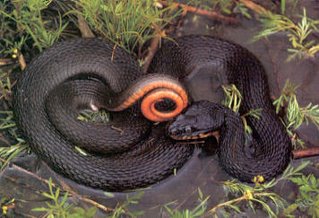Southwestern Missouri: An Eden in So Many Ways

It could very well be that you are all well aware of snake migration and are, even as you read this, watching your step. Reaffirming in a quivery, slithery way, the weirdness of Nature, here is an explanation of Snake Migration, which as if once weren't enough, is a biennial event and has been for a long time. The description is from a Missouri herpetologist named Wayne, who, under his GardenWeb "Bio" does not flog the same old "School, Family, Secret Abiding Love for Decoupage" screed that we all spout when "Bio" is required, but instead he lists his 2006 "Snake Total to Date" Look at this: "579 snakes, 70 venomous, among them 68 Eastern Yellowbelly Racers and an Osage Copperhead" that he describes as a 'lifer'. This of course, tells us all a lot more about Wayne than anything anybody could say about secret trysts with varnish in the basement, and we say, "Now, that's an interesting guy."
This is what he writes about autumn migration:
"The fall is when the snakes begin traveling back to their winter dens from parts far away (and in the spring, of course, it is when the snakes leave their dens and begin traveling to parts far away).
He continues, "Snakes overwinter in the same den year after year and some of them will travel several miles in the fall to return to their dens. Migrations mostly happen in central states like Missouri, Illinois, Arkansas, and Kentucky and places farther north where snakes spend their winters in large communal dens in bluffs.
Farther south snakes can den almost anywhere (a stump, a rodent hole, etc.) and thus they don't den in large concentrations.
In some places if you are between a denning bluff on one side and good habitat on the other you can walk along and actually see the snakes migrating. The snakes will all be coming from the flats and heading to the bluffs and all will be on the move in the same direction.
On a good day during peak migration you might see as many as 50 to 60 different snakes in a three hour walk. On a more typical day during the peak migration you might see from 12 to 25 snakes in three hours. At the early and late ends of the migration (which lasts for about 2 months) you might see just 4 or 5 snakes. It's really a neat thing to observe!"
And who can deny it?! Certainly, there are Worlds within Worlds. Here is a person striding along between our world and the one that evidently exists between flatland and bluff. What luck it is that he reports back to us as he scuffs through Yellowbelly Racers and Osage Copperheads in their single-mindedly commute as the nights turn chilly, anxious to return home to writhe down and knot up with the gang -some won't have made it, though, and there will be new, uh, faces, too - in the craggy pits and cave shelves, where they'll all hunker down, to snooze until snow-melt.


0 Comments:
Post a Comment
<< Home